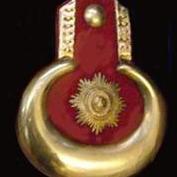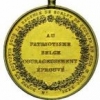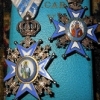-
Posts
91 -
Joined
-
Last visited
-
Days Won
2
farmer last won the day on September 5 2023
farmer had the most liked content!
About farmer

Profile Information
-
Gender
Male
-
Location
Belleville
-
Interests
European Orders with emphasis on Belgian, French and Albanian. I enjoy studying hallmarks and maker marks along with micro photography to capture those.
Photography of OMD's is another interest of mine.
Recent Profile Visitors
farmer's Achievements
-
Interesting indeed! Contrary to what I wrote earlier, perhaps they were the same people, operating 2 jewelry businesses simultaneously in Bucarest and Vienna. Definitely not impossible. Names certainly match (except for Ernst Resch - this name is not mentioned at all in Romanian publications). I did some further reading. According to source in Romania (published for Resch's 100th anniversary by the Guild of jewelers and clock-makers in Romania - in 1937), there were two Lorenz's, the first who purportedly came from the Empire (presumably Vienna) and settled in Brasov (Romania), who was the father of Lorenz II and Josef. Brothers (Lorenz II and Josef) founded the business in Bucarest in 1837. When Josef died, his sons Carol and Heinrich took over (both died in 1930s). The question is, if they indeed operated two businesses, where was the actual manufacturing shop. Often, what is stated on boxes and the documents were retail stores. Josef Resch build his house in Theater district in Bucarest between 1855-57, top floors were the living quarters and the ground floor became their main store. House was sold in 1880 but the retail location remained there, until at least when Heinrich died in 1930. The actual workshop was in another part of Bucarest. Considered provider to the Royal House of Romania at least by 1881, their biggest business was clocks and watches and custom jewellery plus they imported fine things from different parts of Europe. Some of the earliest Romanian orders were retailed by them but in all likelihood made in Austria first (Fischmeister, possibly others). Cheers.
-
Polonia Restituta - variants
farmer replied to Daffy Duck's topic in Central & Eastern European States
-
Hi Zaim, The term "Distinctive" is used in English but usually with addition of the word 'Insignia' - as in DI (distinctive or distinct insignia). Usually (not exclusively) referring to either badge or patch being very specific to a particular formation or unit or such. Bear in mind, this is not a proper terminology yet it is accepted among collectors. As others above specified, you are much better off using the word 'Insignia' as it covers everything and is arguably the most appropriate in your case - especially if you are using English language in your publication. And no, the word 'badge' does not refer specifically to cloth insignia alone (it can be anything), you are probably thinking of the word 'patch' which is normally made in cloth or embroidered etc. Cheers
-
Tomas, Resch in Bucarest (Romania) is most likely different person. Lorenz Resch did move from Vienna to Brasov and then later to Bucharest where he and his brother founded their jewelery business around 1837 (and carried on until around 1945 with four generations of jewelers- who also made orders, medals and decorations but not in the early years of their existance).
-
Decoration of the Red Cross with a particular mark: help wanted
farmer replied to Carlo's topic in Austro-Hungarian Empire
Just a note here, brass is not metal suitable for enameling so it is most likely on base copper or what enamelers call either gilding or enameling alloy (some call it enamel grade tombac or such - there are many names for such alloys). It needs to have under 5% of zinc in it's composition and regular brass has a lot more - which would render enameling very ugly or altogether ineffective. After the fact, it can be indeed silver plated or gold plated (gilded). -
Serbian Order of White Eagle differences
farmer replied to Daffy Duck's topic in Southern European & Balkan States
There is nothing very strange about minor differences. These were very complex pieces with many parts. Most parts were cast and/or die pressed in silver and then hand finished - on occasion casting/stamping was not great, especially as process was repeated over and over. New moulds/dies had to be made and there would be slight differences when compared side by side. This was fairly common order and many were made. If you take your time (as all serious collectors should....) and study the basics of how things were actually manufactured - these are all within normal variances in such. Enamelling followed the hand finishing of parts and thus can also be slightly different from batch to batch - colours can vary etc. I believe Bertrand used Soyer enamels at the time and those would definitely differ from batch to batch - even opaques. In terms of finishing, this also can differ - particular worker could have used graver of somewhat different faceting or his technique was a bit different and you will see this in how his lines were cut. - this was especially evident to engraved embellish lines on the eagles as those would have been engraved after the enamelling process - a finishing touch so to speak. The blue on the crown pendilia has been replaced in some parts - this is rather obvious though. -
Adding to the conversation, this can also mean that manufacturer did not have all gold parts and substituted some in silver (gilded or not) and thus stamped these parts 'A' for Argento. Italian manufacturers were not super observant in terms of hallmarking and some did more then others but their system was not very well defined or stringent prior to 1934 regulations (which took couple of years to implement nation-wide). I would discount the province, as this was usually two letter code but on an off chance, could have indicated the city of production, the only 3 that come to mind are Alessandria, Asti and Arezzo. I also agree that this may have been product of Cravanzola but this firm has gone through so many changes - while retaining the name to some extent and by 1920's it did not manufacture everything yet was one of the biggest retailers of orders and decorations in Italy. Thus, this may have been a sub-contracted item and the actual maker (for argument's sake - let's say Alberti) made the item and marked it before sending off to whoever marketed the final product and had it cased (cases themselves were usually sourced out and printed with name of the retailer or the manufacturer).
-
Unknown Greek? Order - Please help
farmer replied to Kriegsmarine Admiral's topic in Southern European & Balkan States
Very interesting topic. Something to bear in mind - and the foreign translations can be frustrating with such addressing and later research. What we know as the Greek Order of the Phoenix, was founded in 1926 but it was called 'Republican Order of Merit' at the time. It was officially re-named as the Royal Order of the Phoenix on 18th January 1936. -
The photos are not clear enough to be 100% certain as this Order has complex distribution and structure and differences can often be only told by either which branch (as in Priory) of the Order he belonged to and how their insignia were made in terms of appearance. Often, the suspension's appearance and the ribbon itself will 'tell' the actual class/rank. Could be Magistral Grace, Justice, could be Honour and Devotion or both. The order has combination of classes and ranks so it is not exactly the same as most National orders in terms of structures. The period is also troublesome as this Order has been in a constantly changing state in terms of Priories and how they were structured. In general, the post WW1 period saw many changes withing the great 'International' orders such Order of Knights of Malta, St. John, Teutonic, St. Lazarus, etc.
-
Keeping the original topic alive, here is something in friend's collection - perhaps lower class of the older military merit award? Cannot find reference to this particular one anywhere - has anyone seen another like this? It is definitely of the older quality and with white enamel under the National motif/wreath. Cheers!
-
J_medailes started following farmer
-
Belgium belgian Order of Leopold l
farmer replied to Laurence Strong's topic in Northern European & Baltic States
Hi Igor, Nice one! These were French made in slightly smaller (than Dutalis's) size. I have few of these in silver, silver gilt and all are marked with French hallmark (head of hare). All are with swords like yours and have nearly identical centres (double leaves at the bottom of the disc - all Dutalis's had singles). Too bad the reverse is missing. -
Belgium belgian Order of Leopold l
farmer replied to Laurence Strong's topic in Northern European & Baltic States
VC, Just saw your post. I think I can make out the 'sword' silver hallmark on the crown and another one punched to the wreath ties, this assures your cross was manufactured (but not necessarily awarded) prior to 1869. Eyelet mark appears to be partial Buls's mark. Nice cross, too bad the lion is somewhat fatigued. -
Belgium belgian Order of Leopold l
farmer replied to Laurence Strong's topic in Northern European & Baltic States
Hi, You cannot date any of the L1 orders by the 'I' numeral alone on the reverse. As to the mark, became official after 1946. -
Belgium belgian Order of Leopold l
farmer replied to Laurence Strong's topic in Northern European & Baltic States
Yes. Jef, You need a Heremans's lion. Sending you a pm. -
Belgium belgian Order of Leopold l
farmer replied to Laurence Strong's topic in Northern European & Baltic States
I am not sure I follow: "I asked you about the Roman one the orders with the motto in both languages. Could it be? I thought a Roman only one on order to WW2. " If you mean the French only inscriptions vs French and Flemish - dual languages were used after 1951 statutes revision.







